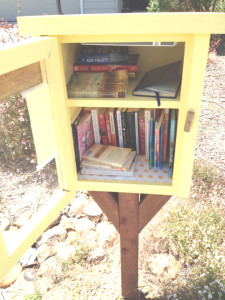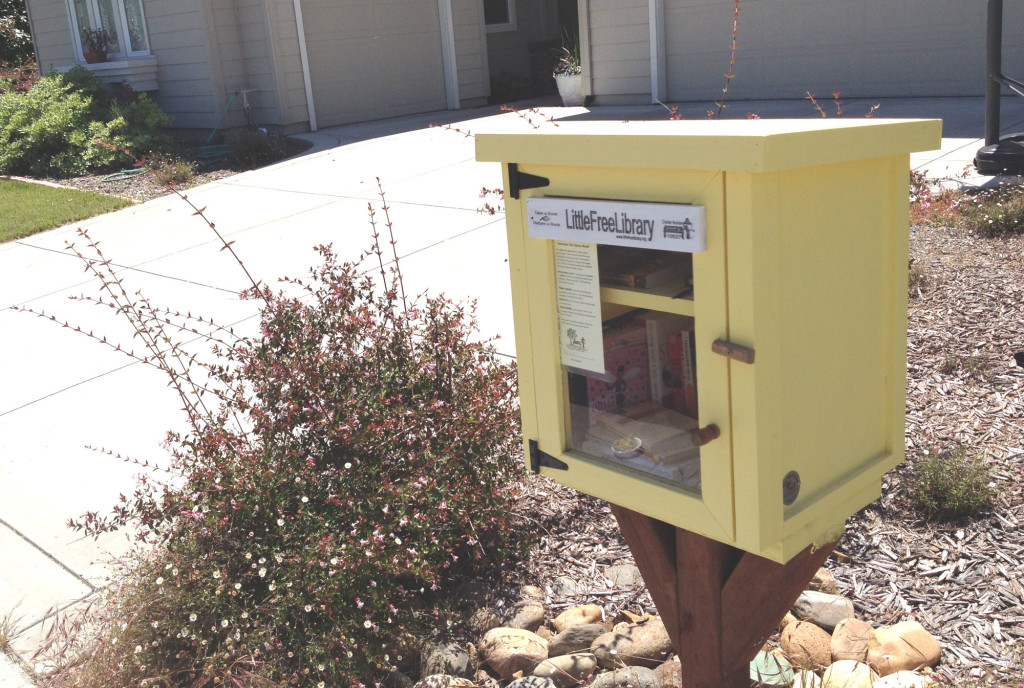Sartor is not worried that someone will take one of the books. In fact, that’s the whole point.
The box called a Little Free Library (LFL), and people are welcome to borrow a book to read.
“About once a week I add more books to it,” she said. “My friends have been generous with donations, and a number of people in the neighborhood are using it as well.”
It’s not a stretch for Sartor and her husband, Vince, to set up a Little Free Library. She’s a part-time librarian at Benicia Public Library, and “doing this at home helps me continue the good feeling I get from helping our patrons,” she said.
The couple first heard about LFLs from a radio broadcast last year. Vince told his wife it sounded “right up my alley,” she said.
Her husband was right. Shortly after they looked online for information about the libraries, they ordered what they needed to get started.
“Before Vince told me about them, I had no idea what they were,” Sartor said.
“I was surprised to learn how widespread they are across the country!”
The Little Free Library movement began in 2009 in Hudson, Wis., where Todd Bol built a model of a one-room schoolhouse to honor his mother, a teacher who had loved reading.
Bol filled the model schoolhouse with books and posted a sign, “Free Books.”
Soon people began asking for little school houses of their own — and so he built more.
Rick Brooks of the University of Wisconsin-Madison saw the little book-filled models as a social enterprise that could do some good.
Inspired by “take one/leave one” book collections in coffee shops, by librarian Lutie Stearns and her turn-of-the-century traveling little libraries and by Andrew Carnegie’s support of free public libraries, Brooks and Bol teamed up, with Bol the craftsman and Brooks the educator and marketer.
The movement grew so large, they hired an Amish carpenter, Henry Miller, to build the little libraries out of recycled wood.
The founders hoped to build 2,510 LFLs to match the public libraries supported by Carnegie. Not only did they reach that goal a year early, the number of registered LFLs is now more than 10 times that number.
But until the Sartors learned about the movement, none had been erected in Benicia.
Sartor searched for any little library or library steward here before putting up her container of books.
“Mine is the first official LFL listed on the map in Benicia,” she said. “A family in Vallejo successfully ‘Kickstarted’ one last year.”
 To save time, the Sartors bought their LFL kit from the movement’s website.
To save time, the Sartors bought their LFL kit from the movement’s website.
The site’s little structures look something like an oversized birdhouse, with a clear door on one side that lets passersby see titles and gives them access to the books inside.
The site promises its library structures can withstand adverse weather conditions.
The different styles have quaint names: Book Lover’s Chalet, Blue Tobacco Barn, Book Garden, Urban Reader, Little Red British Phone Booth and Cedar Sunset.
“My style is the Amish Two Story,” Sartor said.
“It arrived unprimed, so we put two coats of exterior primer on it. After that dried, we painted it with some exterior paint. I put down a bit of shelf paper, which helps cover up the screws that attach the LFL to its post,” she said.
When the couple first installed the library, Benicia was still on standard time. “The area around the LFL would get dark fairly early in the evening,” Sartor said. So her husband installed a motion-detecting light so visitors could get a better view of the available books.
The reaction, she said, has been positive.
“My friends, co-workers, and the neighbors I’ve spoken with all gush about it,” she said. “Everyone loves the idea.”
She said she hopes her little library does more than encourage neighbors to read.
“Putting a LFL in front of my house is a way to — hopefully — bring my immediate neighbors closer together, and foster a sense of community for our little area,” she said.
And it seems to be working.
“I put a journal and a pen in the top shelf with an explanation of who I am and what the LFL is about. Many people have written a blurb in the journal, often one of thanks,” Sartor said.
“The comments are all positive and sweet. It warms my heart to know that the LFL has brightened some people’s day.”
While LFL book readers may return the volume they’ve borrowed, it’s not required, Sartor said. “You can take and keep them forever. Or give them to your granny or best friend.”
The LFL is also a place where people can share books they’ve read, “a book that you feel someone else might enjoy,” she said.
She said people also donate books to Benicia Public Library, though most of them go to the Friends of the Library book sales, another way books find new homes.
And she’s discovered that with these little libraries, content is what the surrounding community makes available.
Sartor said she’d like to see more LFLs crop up throughout Benicia and Vallejo — and elsewhere.
“Just looking at the LFL map, one can see a huge gap in Nevada, so I think it’d be neat to see some there,” she said.
Those interested in becoming a Little Free Libraries steward can order a book-holding structure, plans or kits from the website http://littlefreelibrary.org.







Leave a Reply